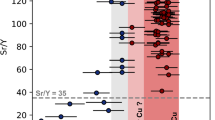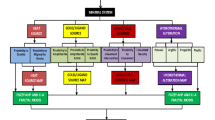Abstract
In this paper, we explore unsupervised cluster analysis to aid mineral prospectivity mapping (MPM) in two aspects: (1) to cluster geochemical data for MPM based on detailed analysis of evidence maps and (2) to explore coherence of spatial signatures at/around mineralized locations as well as outliers of geochemical data. To do so, a systematic procedure is proposed based on the Iterative Self-organizing Data Analysis Techniques Algorithm (ISODATA). Through this procedure, the detailed analysis of evidence maps in Hezuo–Meiwu district, Gansu Province, China, which portray five selected geochemical elements, showed that clusters with and without mineralized locations provide insight to weighing of each evidence. Finally, through the integration of evidence maps, the favorability score map yielded high AUC (> 0.80) for delineating various mineralized locations in the study area, which proves the efficacy of unsupervised cluster analysis as an aid to MPM. Moreover, the coherence of spatial signatures of known mineralized locations, which comprise a training dataset, is vital to data-driven MPM. Groupings of mineralized locations based on the ISODATA and visual inspection supported by PCs from principal component analysis imply that different deposit types may share the same or similar spatial signature and outliers in geochemical data may be potential training samples used for data-driven MPM. Mineralized locations of the same deposit type may show significant dissimilarity. However, this provides insights into selecting mineralized/non-mineralized locations for creation of training datasets. Interestingly, in the study area, major mineralized locations in zones divided by regional fault are clustered separately into two groups. This result not only proves that cluster analysis is effective for exploring the coherence of spatial signatures at/around mineralized locations, but it also justified our previous study, whereby we performed MPM by zones using machine learning algorithms.

modified from Sui et al. 2017). Inset map of China from: http://bzdt.ch.mnr.gov.cn/















Similar content being viewed by others
References
Abbas, A., Minallh, N., Ahmad, N., Abid, S., & Khan, M. (2016). K-Means and ISODATA clustering algorithms for landcover classification using remote sensing. Sindh University Research Journal-SURJ (Science Series), 48(2).
Abedi, M., Norouzi, G. H., & Torabi, S. A. (2013). Clustering of mineral prospectivity area as an unsupervised classification approach to explore copper deposit. Arabian Journal of Geosciences, 6(10), 3601–3613.
Ball, G. H., & Hall, D. J. (1965). ISODATA, a novel method of data analysis and pattern classification: Stanford research inst Menlo Park CA.
Bradley, A. P. (1997). The use of the area under the ROC curve in the evaluation of machine learning algorithms. Pattern Recognition, 30(7), 1145–1159.
Carranza, E. J. M. (2008). Geochemical anomaly and mineral prospectivity mapping in GIS. Elsevier.
Carranza, E. J. M. (2010). Improved wildcat modelling of mineral prospectivity. Resource Geology, 60(2), 129–149.
Carranza, E. J. M., & Hale, M. (2000). Geologically constrained probabilistic mapping of gold potential, Baguio district, Philippines. Natural Resources Research, 9(3), 237–253.
Carranza, E. J. M., & Hale, M. (2001a). Geologically constrained fuzzy mapping of gold mineralization potential, Baguio district, Philippines. Natural Resources Research, 10(2), 125–136.
Carranza, E. J. M., & Hale, M. (2001b). Logistic regression for geologically constrained mapping of gold potential, Baguio district, Philippines. Exploration and Mining Geology, 10(3), 165–175.
Carranza, E. J. M., & Hale, M. (2003). Evidential belief functions for data-driven geologically constrained mapping of gold potential, Baguio district, Philippines. Ore Geology Reviews, 22(1–2), 117–132.
Carranza, E. J. M., Hale, M., & Faassen, C. (2008). Selection of coherent deposit-type locations and their application in data-driven mineral prospectivity mapping. Ore Geology Reviews, 33(3–4), 536–558.
Carranza, E. J. M., & Laborte, A. G. (2015a). Data-driven predictive mapping of gold prospectivity, Baguio district, Philippines: Application of random forests algorithm. Ore Geology Reviews, 71, 777–787.
Carranza, E. J. M., & Laborte, A. G. (2015b). Random forest predictive modeling of mineral prospectivity with small number of prospects and data with missing values in Abra (Philippines). Computers & Geosciences, 74, 60–70.
Carranza, E. J. M., Owusu, E. A., & Hale, M. (2009). Mapping of prospectivity and estimation of number of undiscovered prospects for lode gold, southwestern Ashanti Belt, Ghana. Mineralium Deposita, 44(8), 915–938.
Carranza, E. J. M., & Hale, M. (2002). Wildcat mapping of gold potential, Baguio district, Philippines. Applied Earth Science, 111(2), 100–105.
Carranza, E. J. M., & Laborte, A. G. (2016). Data-driven predictive modeling of mineral prospectivity using Random Forests: A case study in Catanduanes Island (Philippines). Natural Resources Research, 25, 35–50.
Chen, Y. Y., & Gong, Q. S. (2007). Discussion on the division of deposit scale and the index of ore prospecting. Gansu Geology, 16(3), 6–11.
Chung, C. J., & Keating, P. B. (2002). Mineral potential evaluation based on airborne geophysical data. Exploration Geophysics, 33(1), 28–34.
Clare, A., & Cohen, D. (2001). A comparison of unsupervised neural networks and k-means clustering in the analysis of multi-element stream sediment data. Geochemistry: Exploration, Environment, Analysis, 1(2), 119–134.
Everitt, B. (1974). Cluster analysis heinemann educational London. Heinemann Educational: London, UK.
Ghezelbash, R., Maghsoudi, A., & Carranza, E. J. M. (2019). Mapping of single-and multi-element geochemical indicators based on catchment basin analysis: Application of fractal method and unsupervised clustering models. Journal of Geochemical Exploration, 199, 90–104.
Ghezelbash, R., Maghsoudi, A., & Carranza, E. J. M. (2020). Sensitivity analysis of prospectivity modeling to evidence maps: Enhancing success of targeting for epithermal gold, Takab district NW, Iran. Ore Geology Reviews, 120, 103394.
Gordon, A. (1999). Classification. . New York: Chapman and Hall.
Hart, C. J., Baker, T., & Burke, M. (2000). New exploration concepts for country-rock-hosted, intrusion-related gold systems: Tintina gold belt in Yukon. The Tintina gold belt: concepts, exploration and discoveries. British Columbia and Yukon Chamber of Mines, Special, 2, 145–172.
Hronsky, J. M., & Kreuzer, O. P. (2019). Applying spatial prospectivity mapping to exploration targeting: Fundamental practical issues and suggested solutions for the future. Ore Geology Reviews, 107, 647–653.
Jain, A. K. (2010). Data clustering: 50 years beyond K-means. Pattern Recognition Letters, 31, 651–666.
Lang, J. R., & Baker, T. (2001). Intrusion-related gold systems: The present level of understanding. Mineralium Deposita, 36(6), 477–489.
Li, J. W., Sui, J. X., Jin, X. Y., Wen, G., Chang, J., Zhu, R., et al. (2019). The intrusion-related gold deposits in the Xiahe-Hezuo District. West Qinling Orogen: Geodynamic setting and exploration potential. Earth Science Frontier, 26(5), 017–032.
Liu, F. T., Ting, K. M., & Zhou, Z. H. (2012). Isolation-based anomaly detection. ACM Transactions on Knowledge Discovery from Data (TKDD), 6(1), 1–39.
MacQueen, J. (1967). Some methods for classification and analysis of multivariate observations. Paper presented at the Proceedings of the fifth Berkeley symposium on mathematical statistics and probability.
Memarsadeghi, N., Mount, D. M., Netanyahu, N. S., & Le Moigne, J. (2007). A fast implementation of the ISODATA clustering algorithm. International Journal of Computational Geometry & Applications, 17(01), 71–103.
Meng, Q. R., & Zhang, G. W. (2000). Geologic framework and tectonic evolution of the Qinling orogen, central China. Tectonophysics, 323(3–4), 183–196.
Moeini, H., & Torab, F. M. (2017). Comparing compositional multivariate outliers with autoencoder networks in anomaly detection at Hamich exploration area, east of Iran. Journal of Geochemical Exploration, 180, 15–23.
Moon, W. M. (1990). Integration of geophysical and geological data using evidential belief function. IEEE Transactions on Geoscience and Remote Sensing, 28(4), 711–720.
Moon, W. M., & An, P. (1991). Integration of geophysical, geological and remote sensing data using fuzzy set theory. Geoinformatics, 2(2), 171–176.
Nykänen, V., Lahti, I., Niiranen, T., & Korhonen, K. (2015). Receiver operating characteristics (ROC) as validation tool for prospectivity models: A magmatic Ni–Cu case study from the Central Lapland Greenstone Belt, Northern Finland. Ore Geology Reviews, 71, 853–860.
Pourghasemi, H. R., & Kerle, N. (2016). Random forests and evidential belief function-based landslide susceptibility assessment in Western Mazandaran Province, Iran. Environmental Earth Sciences, 75(3), 185.
Qi, J.H., Li, Z.C., & Wang, X.W. (2013). Report on the Prospect Survey of Mines in Hezuo-Meiwu district. Gansu: Third Institute Geological and Mineral Exploration of Gansu provincial Bureau of Geology and Mineral Resources, Gansu, China (in Chinese).
Rock, N.M.S. (1988). Numerical Geology. Lecture Notes in Earth Sciences 18, Springer Verlag, New York-Berlin-Heidelberg, 427pp.
Singer, D. A. (1993). Basic concepts in three-part quantitative assessments of undiscovered mineral resources. Nonrenewable Resources, 2(2), 69–81.
Stensgaard, B. M., Chung, C. J., Rasmussen, T. M., & Stendal, H. (2006). Assessment of mineral potential using cross-validation techniques and statistical analysis: A case study from the Paleoproterozoic of West Greenland. Economic Geology, 101(7), 1397–1413.
Sui, J. X., Li, J. W., Wen, G., & Jin, X. Y. (2017). The Dewulu reduced Au-Cu skarn deposit in the Xiahe-Hezuo District, West Qinling orogen, China: Implications for an intrusion-related gold system. Ore Geology Reviews, 80, 1230–1244.
Sui, J.X., Li, J.W., Hofstra, A. H., O'Brien, H., Lahaye, Y., Yan, D., et al. (2020). Genesis of the Zaozigou gold deposit, West Qinling orogen, China: constraints from sulfide trace element and stable isotope geochemistry. Ore Geology Reviews, 103477.
Sun, T., Li, H., Wu, K., Chen, F., Zhu, Z., & Hu, Z. (2020). Data-driven predictive modelling of mineral prospectivity using machine learning and deep learning methods: A case study from Southern Jiangxi Province, China. Minerals, 10(2), 102.
Templ, M., Filzmoser, P., & Reimann, C. (2008). Cluster analysis applied to regional geochemical data: Problems and possibilities. Applied Geochemistry, 23(8), 2198–2213.
Torppa, J., Nykänen, V., & Molnár, F. (2019). Unsupervised clustering and empirical fuzzy memberships for mineral prospectivity modelling. Ore Geology Reviews, 107, 58–71.
Wang, J., Zhou, Y., & Xiao, F. (2020). Identification of multi-element geochemical anomalies using unsupervised machine learning algorithms: A case study from Ag-Pb-Zn deposits in north-western Zhejiang, China. Applied Geochemistry, 104679.
Xiong, Y., & Zuo, R. (2016). Recognition of geochemical anomalies using a deep autoencoder network. Computers & Geosciences, 86, 75–82.
Yeung, K. Y., & Ruzzo, W. L. (2001). An empirical study on principal component analysis for clustering gene expression data. Bioinformatics, 17(9), 763–774.
Yousefi, M., & Carranza, E. J. M. (2015a). Fuzzification of continuous-value spatial evidence for mineral prospectivity mapping. Computers & Geosciences, 74, 97–109.
Yousefi, M., & Carranza, E. J. M. (2015b). Prediction–area (P–A) plot and C–A fractal analysis to classify and evaluate evidential maps for mineral prospectivity modeling. Computers & Geosciences, 79, 69–81.
Yousefi, M., & Carranza, E. J. M. (2016). Data-driven index overlay and Boolean logic mineral prospectivity modeling in greenfields exploration. Natural Resources Research, 25(1), 3–18.
Yousefi, M., & Nykänen, V. (2016). Data-driven logistic-based weighting of geochemical and geological evidence layers in mineral prospectivity mapping. Journal of Geochemical Exploration, 164, 94–106.
Zekri, H., Cohen, D. R., Mokhtari, A. R., & Esmaeili, A. (2019). Geochemical prospectivity mapping through a feature extraction–selection classification scheme. Natural Resources Research, 28(3), 849–865.
Zhang, S., Xiao, K., Carranza, E. J. M., & Yang, F. (2018). Maximum entropy and random forest modeling of mineral potential: Analysis of gold prospectivity in the Hezuo-Meiwu District, West Qinling Orogen, China. Natural Resources Research, 28(3), 645–664.
Zuo, R. G., Xiong, Y. H., Wang, J., & Carranza, E. J. M. (2019). Deep learning and its application in geochemical mapping. Earth-Science Reviews, 192, 1–14.
Acknowledgments
Funding support for this research was derived from the National Key Research and Development Program of China (Project No. 2017YFC0601501), The China National Mineral Resources Assessment Initiative (Project Nos. 1212010733806 and 1212011120140), National Natural Science Foundation of China (NNSFC, Project No. 42002298) and China Scholarship Council (CSC No.201906400022).
Author information
Authors and Affiliations
Corresponding author
Rights and permissions
About this article
Cite this article
Zhang, S., Carranza, E.J.M., Xiao, K. et al. Geochemically Constrained Prospectivity Mapping Aided by Unsupervised Cluster Analysis. Nat Resour Res 30, 1955–1975 (2021). https://doi.org/10.1007/s11053-021-09865-x
Received:
Accepted:
Published:
Issue Date:
DOI: https://doi.org/10.1007/s11053-021-09865-x




